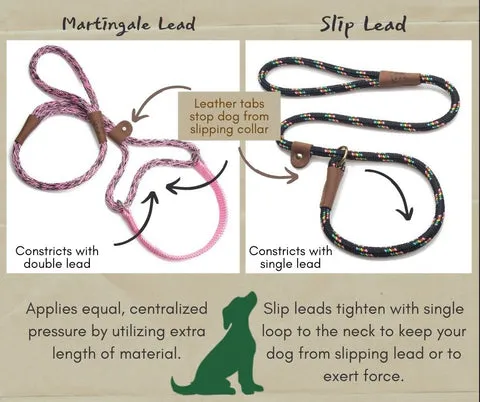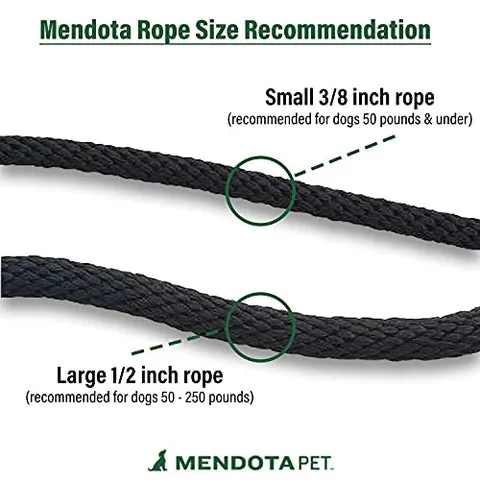Successfully training a dog to walk politely on a leash is a rewarding experience for any dog owner. We’ve all witnessed the struggle of an enthusiastic dog pulling its owner down the street, and ensuring your furry companion walks calmly by your side is key to enjoyable outings. The right leash can make all the difference, transforming walks from a battle of wills into a pleasant bonding activity. This guide will explore various types of leashes, highlighting their specific benefits and considerations to help you find the Best Leash For Training A Dog To Walk effectively and safely, laying the groundwork for basic training and beyond. Building a strong foundation with your puppy’s early experiences is crucial for future success, as understanding puppy training basics the first week can significantly impact their leash manners.
Slip Leads: A Popular Choice for Control
The slip lead is a highly favored tool among trainers, breeders, and rescue organizations for its versatility and immediate control. It functions as both a collar and a leash, making it easy to gain control over a dog whether or not they are already wearing a collar. The key to its effectiveness lies in understanding how to use it correctly. This lead is particularly ideal for quickly moving dogs from one location to another, such as within a shelter or a breeding facility, as it prevents your pet from slipping out of the lead.
A well-designed slip lead often features an easily adjustable leather tab or stopper that allows you to secure the loop around the dog’s neck. This ensures that the lead remains in place, even when loose, preventing it from slipping over their head. For proper fit, you should typically be able to slide two to three fingers comfortably between the loop and your dog’s neck. While excellent for general control and walks once your dog has learned to heel, the slip lead is generally not recommended for dogs that are chronic pullers. Constant pressure on the neck, throat, and spine can lead to discomfort or injury. Instead, for persistent pullers, it’s best to introduce reward-based training in a controlled environment before transitioning to a slip lead for walks. The ability to manage a dog’s behavior on the leash is essential from a young age, especially when addressing issues like how to stop puppy biting lead when walking.
Once your dog has mastered the “heel” command and understands polite leash manners, the slip lead becomes an excellent tool for everyday walks, offering a secure and responsive connection. When selecting a slip lead, consider the appropriate size for your dog. They are typically available in various diameters, such as ⅜” and 1”, and lengths ranging from 4 to 6 feet, allowing you to choose one that best suits your dog’s size and your specific training needs.
 A slip lead, also known as a Martingale lead, securely fitted around a dog's neck, illustrating proper use for training.
A slip lead, also known as a Martingale lead, securely fitted around a dog's neck, illustrating proper use for training.
Martingale and Dog Walker Leashes: Gentle No-Slip Options
For those who prefer an alternative to traditional slip leads, martingale collars offer a “no-slip” solution. Martingales are historically used for breeds with narrow heads, such as Greyhounds, or for dogs that are prone to backing out of their collars when frightened or surprised. Unlike standard collars, they typically don’t have a buckle closure but instead slip over the dog’s head and then tighten gently when pulled, preventing escape without applying excessive pressure.
The Dog Walker is often a larger version of the martingale, designed specifically for bigger dogs. Both martingales and dog walkers are excellent choices for teaching your dog to heel in a controlled setting. Similar to slip leads, it’s vital to minimize constant pressure on your dog’s throat and neck during training. While a slight, corrective tension is acceptable, prolonged or harsh pulling should be avoided. These leash types allow for precise adjustments without putting undue pressure on sensitive areas, providing both comfort and security for you and your pet during walks. Selecting the correct width, such as ⅜” or 1”, and ensuring proper adjustment are crucial for effective and humane training, particularly when you train your dog to not pull on leash.
The EZ Trainer: Harness-Style Control
The EZ Trainer is an innovative leash system developed in collaboration with leading obedience and field dog trainers. It stands out from many other head halters and harnesses by avoiding the application of extra pressure in areas that commonly stress dogs. This design makes it significantly easier to use while maintaining effective control.
The EZ Trainer is specifically designed to assist in teaching several fundamental commands and behaviors, including:
- Heeling politely by your side
- Sitting on command
- Stopping unwanted jumping
- Learning the “whoa” command
A unique feature of the EZ Trainer is its extra loop, which allows you to fashion a harness that applies pressure to the dog’s abdomen rather than its neck. This ingenious design greatly enhances safety compared to traditional slip leads, and makes it considerably easier to maintain control of your dog throughout the training process. Many trainers consider the EZ Trainer one of the most effective leashes for achieving rapid progress, often providing noticeable control within just a few sessions. This tool offers a gentle yet firm way of teaching your dog to not pull on leash by redirecting their natural instincts.
Snap Leads: Versatile for Everyday Walks and Untrained Dogs
The snap lead is arguably the most ubiquitous type of leash available on the market, recognizable by its clip that attaches to a collar or harness. Its widespread popularity stems from its incredible versatility, as it can be used with almost any standard collar or specialized harness. This makes it one of the safest and most adaptable leads for various situations.
For dogs that have not yet been trained to heel, the snap lead is an ideal starting point. Because it attaches to a collar or harness, it significantly reduces the risk of injury to your dog’s spine or neck, which can sometimes occur with improper use of other training leads. This makes it an excellent choice for keeping your dog under control in diverse environments while you work on their foundational training. Choosing the correct width and length is important for optimal control and comfort. For smaller dogs weighing under 50 lbs, a ⅜” width in lengths of 4, 6, or 15 feet is generally suitable. Larger dogs over 50 lbs typically benefit from a 1” width in similar lengths. The ideal length will depend on your dog’s size and the activities you plan to engage in. For instance, a Pomeranian might thrive with a ⅜” diameter, 6-foot length leash, offering both security and ample room for the owner. In contrast, a German Shepherd might require a 1” lead in a 4-foot or 6-foot length, depending on the desired freedom during training sessions.
 An image illustrating various rope sizes and thicknesses, demonstrating the different diameters available for leashes.
An image illustrating various rope sizes and thicknesses, demonstrating the different diameters available for leashes.
Specialized Leashes for Specific Training Needs
Beyond the general-purpose leashes, several specialized leads are designed for particular training scenarios, offering targeted control and functionality.
Traffic Leads: Short Control for Tight Spaces
Traffic leashes are exceptionally short snap leads, typically around 1.5 feet in length. Their primary purpose is to provide immediate, close-quarter control over a large dog in confined or high-traffic areas. Available in both leather and polypropylene rope, these leads are invaluable in a variety of situations:
- Navigating crowded city sidewalks with a large dog.
- Preventing your dog from jumping out of the car as you open the door.
- Securely fastening your dog via a harness in an off-road vehicle.
- Reinforcing the “heel” command in situations demanding utmost control.
Check Cords: Long Lines for Field and Recall Training
Check cords are extended snap leads specifically designed for training dogs in open fields or competitive settings. These long lines allow the handler to maintain a significant distance from the dog while still keeping them safely leashed. They are particularly effective for:
- Field work, such as bird dog training.
- Teaching and reinforcing reliable recall from a distance.
- General obedience training, providing space for commands like “stay.”
- Facilitating the transition to off-leash work, offering a safety net.
Mendota Pet’s check cords are crafted from durable multi-filament polypropylene roping, identical to the material used in their other high-quality products. These long lines are often UV-coated to resist decay and fading, and are designed to be gentle on the hands, even during extended training sessions. Professional trainers frequently choose their trainer and super cords for mastering commands like “come” and “retrieve to hand.” They are available in various standard and custom lengths, including Obedience (⅜” x 20 ft), Trainer (⅜” x 30 ft, ⅜” x 50 ft), Protrainer (½″ x 30), and Supercord (7/16″ x 30 ft, 7/16″ x 50 ft). Understanding how different leashes can aid various training goals, including how to teach a dog for specific support roles, provides a holistic view of canine education, such as how to train puppy for emotional support.
Conclusion
Choosing the best leash for training a dog to walk is a crucial step towards developing a well-behaved companion and enjoying stress-free outings. Each type of leash – from the versatile slip lead and gentle martingale to the innovative EZ Trainer, everyday snap lead, and specialized traffic leads or check cords – offers distinct advantages for different training stages and needs. By understanding the characteristics and proper application of each, you can select the most effective tool to teach your dog polite leash manners, prevent pulling, and ensure their safety. Ultimately, the goal is to foster a strong bond and clear communication with your dog, making every walk a positive and enjoyable experience for both of you. If you have further questions or need personalized advice on selecting the ideal leash for your dog’s training, you can always reach out to experts.
